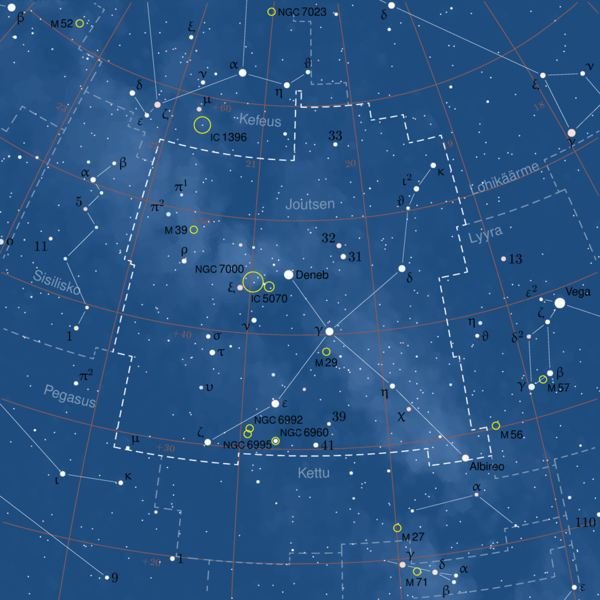The Story Behind the Mysterious Bright Star in Cygnus - Deneb
Getting to Know the Giant Star
Deneb star is among the most magnificent blue-white supergiants known so far. It features as the bright star in Cygnus constellation (Alpha Cygni) and it is also the 19th brightest star in the sky.
Although, it has been widely studied, some basic features such as its distance, can only be estimated. This results in uncertainties as far as its luminosity and evolutionary state are concerned. Despite these uncertainties, the star has to reveal some very interesting facts. It is currently losing mass at a rate of 1.7 ± 0.4 × 10-7 solar masses per year, this is 40 million times the flow rate from the Sun, through a fierce stellar wind and it is classified as a pulsating variable star due to the variations in its light spectrum.
Although it is not as big as Betelgeuse and Antares, it appears to be the most energetic compared to other similar A-type stars . However, the future of Deneb is already set. The star will grow larger evolving into a red supergiant and will finally end up exploding as a supernova in a few million years.
Basic Characteristics

The name ‘Deneb’ has its origins in an Arabic phrase, “Al Dhanab al Dajajah” which means “the hen’s tail” and it denotes its position in the constellation; the tail of the swan. Other names are ‘Deneb el Adige’, ‘Arided’, ‘Aridif’ and ‘Arrioph’. The two latter derive from the Arabic word ‘Al Ridf’, meaning “the hindmost”, while the name ‘Arided’ has a more vague meaning. Another name for the star is ‘Gallina’ which means “hen” in Latin. It was originally used to denote the constellation, although it was later on used for the star itself. Some of the most important characteristics are listed below:
Surface temperature: ~8,400°K
Spectral type: A2Ia
Apparent magnitude: 1.25
Absolute magnitude: -7.0
Distance: 1,340-1,840 ly (light-years)
Luminosity: ~54,000 times the luminosity of Sun
Mass: 20-25 times the mass of the Sun
Radius: ~ 220 times the radius of the Sun
Rotation velocity: 30 kilometers per second
Planets: None
Constellation: Cygnus the Swan
Other stars in Cygnus: The most important are Albireo (Beta Cygni), 61 Cygni, and V508 Cygni and XX Cygni variable stars. There is a total of 84 stars in the constellation.
Other Interesting Facts:
- One of the largest white stars known so far.
- It takes almost half a year to make a full rotation.
- If placed at the center of our Solar System, it would extend to the orbit of the Earth_._
- It is the furthest first-magnitude star from Earth.
- It is currently the north pole star of Mars.
- 18,000 years ago, it was standing just 7 degrees off our North Celestial Pole and it will be in the same position again in the year 9800 approximately.
- If placed at the distance of Vega (~25 light-years), it would have a magnitude of - 7.8, shine 15 times more brightly than Venus, would cast shadows on the ground, and easily be visible in daylight.
Spot the Blue Star in the Night Sky

Another remarkable fact about Deneb is that it belongs to three different star patterns. As mentioned above, it is the brightest star of Cygnus, a constellation which resembles a swan or some kind of a stellar bird. It also belongs to a triangle-like formation known as the Summer Triangle, which incorporates Vega and Altair as well (see image). Finally, it marks the head of the Northern Cross, an asterism which is part of the Cygnus constellation. In the same region also lies a number of nebulae that deserve some extra attention from the night-sky observer. Among the most notable are the North America Nebula (NGC 7000), and the Pelican Nebula (IC 5070).
So, what is the best place and time to gaze at this star? It can be easily spotted from any location of about 45 degrees north latitude. This is due to the fact that it is a circumpolar star, circling around the pole star and never setting. Therefore, observations from regions southern to this latitude are not possible. The best time to see this supergiant, is late at spring and during the summer months, as it rises from the northeastern horizon. At about August 1 at midnight, it reaches its highest point in the sky (culmination) and it offers an amazing opportunity to admire its blue-tinted color.
Sources:
- Sessions L. “Deneb: Among most distant stars visible”, EarthSky
- The Dome of the Sky (domeofthesky.com)
- Kaler J. “Deneb”, astro.illinois.edu
- Rao J. “Doorstep Astronomy: The Summer Triangle”, Space.com
Image Credits:
- “Comparison Between Deneb and the Sun. The Radius of Deneb is approximately 220 Times the Radius of the Sun” by Uwe Dedering
- Cygnus Constellation by Ville Koistinen
- The asterism of the Summer Triangle composed of the three bright stars Vega (top left), Altair (lower middle) and Deneb (far left) by A. Fujii
This post is part of the series: Bright and Famous Stars
Amazing facts and details on some of the most beautiful stars in the night sky.
